Longines’ V.H.P. (Very High Precision) calibre was relaunched this year, 35 years after it was invented, in 1984. It is already a great success, installed within the Conquest collection, as it was in the past.

Its defining features are: ultra-precision (±5 sec/yr), the ability to readjust its hands after a shock or exposure to magnetic fields thanks to the GPD (gear position detection) system, a 5-year autonomy, battery end-of-life indicator and perpetual calendar. The V.H.P. was launched on 9 March 2017. Its current ubiquity should not, however, eclipse its historic antecedents, which are far less well known.
1940: the foundations of quartz
Contrary to popular belief, quartz was not born in 1969! Yes, it was the year of the first quartz watches, thanks to the considerable efforts made by Seiko, Girard-Perregaux and others to standardise, miniaturise and improve battery life. However, quartz technology itself existed well before that; since the 1940s, in fact, when it was used in sports timing instruments. Longines was one of the pioneers. The Chronocamera, introduced in 1950, was able to automatically record times with an accuracy of 1/100th of a second.

Then came the Chronocinégines, which was unveiled in May 1954 at the Neuchâtel Observatory. It comprised a 16 mm camera coupled with a Longines quartz clock that had an autonomy of 24 hours, and could also measure times to the nearest 1/100th of a second. It marked a decisive turning point.
Electric trials
Despite this success, Longines did not immediately launch into what would become the quartz watch. Between 1957 and 1964, the company focused on researching the concept of an electric watch. A movement was developed and tested in-house, but never made it to market. Longines subsequently looked into using a quartz movement in a dashboard clock. The result was the same: a high-precision movement was developed but never went on sale.
Clinergic: the ancestor of the El Primero?
Another promising avenue explored in the 60s is now almost completely forgotten: the Clinergic escapement, as used in Ultra-Chron watches. It owed its invention to the realisation that Seiko was making great strides in developing an ultra-precise quartz watch that would probably leave mechanical watches in the dust. In response to this threat, Longines decided it would be a good bet to increase the frequency of the oscillator (as in quartz).

In the 1960s, almost all watches beat at 18,000 vibrations per hour. Longines’ idea was to increase precision by simply doubling this frequency, to 36,000 vph. Thus was born the calibre 430 with a Clinergic escapement, introduced in the Ultra-Chron collection. The instinct was spot on. But Longines opted to stay with 3-handed watches, without developing any chronographs. This lack of vision proved costly. Two years later, Zenith went ahead and developed the El Primero, probably the most well-known calibre in watch history. It may well never have seen the light of day, had Longines not developed the calibre 430 two years earlier.

A family affair
So, what has this got to do with the V.H.P.? Well, the V.H.P. is really just the logical successor of these multiple versions developed from the 40s to the 60s. It is the son of the Beta 21 calibre, the first quartz wristwatch movement used by Longines, which was completed on 20 August 1969 (codename: Project Hourglass!). It is the grandson of the calibre 430, and the great-grandson of the Chronocamera.

The V.H.P. would not have happened without two things: the increase in market demand throughout the 1970s and 80s, coupled with Longines’ decision to promote quartz. Quartz movements accounted for 10% of its watches in 1977, 18% in 1979, 57% in 1980 and a decisive 90% in 1984, the year the V.H.P. was released. Today, 35 years later, a V.H.P. calibre is not just a symbol of modernity, it’s also a tangible piece of watch history.





